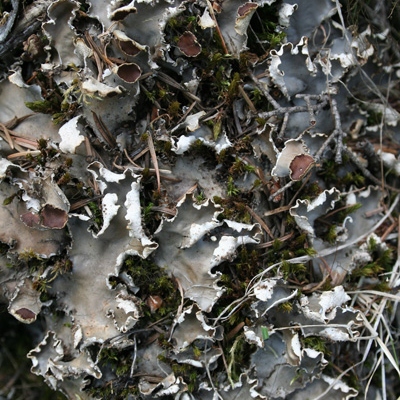Chickakoo is one of my favorite hiking places close to Edmonton. The aspen dominated mixedwoods blend with birch stands, and the little lakes and rolling topography are welcome after the tablelands of my Edmonton 'hood. Both are open and humid enough to host a fun diversity of epiphytic (=tree-dwelling) lichens.
The flora is typical of the Parkland and dry Boreal Natural Regions, but the protected nature of Chickakoo means that some lichen colonies have grown impressively large. From plate-sized Flavopunctelia to copious colonies of Alberta's namesake lichen (Melanelixia albertana), Chickakoo is a fun place to get to know some of our central Alberta lichens.
The most common growth form is the leafy lichens. Like many dry and periurban areas, fruticose lichens are more limited.
In support of a casual ANPC walk, here are a list of some of the species to be seen, organized by growth form and color. I will start with the grey foliose, from largest to smallest.
If you are looking for more than the short biobits below, try this resource with images, keys, and descriptions of all lichens known from Edmonton. To date it also covers all of the lichens I’ve observed at Chickakoo.
Haughland, D.L., A. Hood, D. Thauvette, S.A. Toni, M. Cao, J.D. Birch, J. Wasyliw, L. Hjartarson, M. Villeneuve, A. Stordock, D.A. Fielder, M. Lewis, D. Evans, D. Royko, R. Bolduc, H. Webster, J.D. Singh, K.A. Schafer, S. Goyette, H.E. Davidson & C. Shier. 2022. Getting to know our biomonitor neighbours: urban lichens and allied fungi of Edmonton, Alberta, Canada. Opuscula Philolichenum 21: 33-181.
Freely available at: https://www.nhm2.uio.no/botanisk/lav/RLL/PDF/R43924.pdf or http://sweetgum.nybg.org/science/op/biblio_details.php?irn=484805
Punctelia caseana Look for the white dotted upper surface and the pale lower with buzz-cut-like attachments (=rhizines).
https://inaturalist-open-data.s3.amazonaws.com/photos/262903685/original.jpg

Parmelia sulcata An Alberta chameleon, look for the hammered upper skin and the jet black lower surface with black rhizines that branch like little pipecleaners.
https://inaturalist-open-data.s3.amazonaws.com/photos/262903664/original.jpg

Phaeophyscia kairamoi They key trait is the granular soredia that develop tiny hairs, bristling around the lobe margins.
https://inaturalist-open-data.s3.amazonaws.com/photos/262954424/original.jpg

Physcia aipolia Look for flat narrow lobes with sponge-painting like white marks (=maculae) and the tightly-attached black fruiting bodies.
https://inaturalist-open-data.s3.amazonaws.com/photos/262903649/original.jpg

Heterodermia galactophylla (one of my favorite finds - how can you not love a centipede lichen). The ends of the lobes form lip-like soralia, and the edges of the lobes sprout multi-branched cilia.
https://inaturalist-open-data.s3.amazonaws.com/photos/262903631/original.jpg

Physcia stellaris Like aipolia, but lobes more convex and fruiting bodies on little stipes.
https://inaturalist-open-data.s3.amazonaws.com/photos/262953319/original.jpg

Physcia adscendens A tiny and common lichen, made of little more than hooded soralia and cilia. Superficially similiar to but smaller than Heterodermia.
https://static.inaturalist.org/photos/182949770/original.jpeg





























